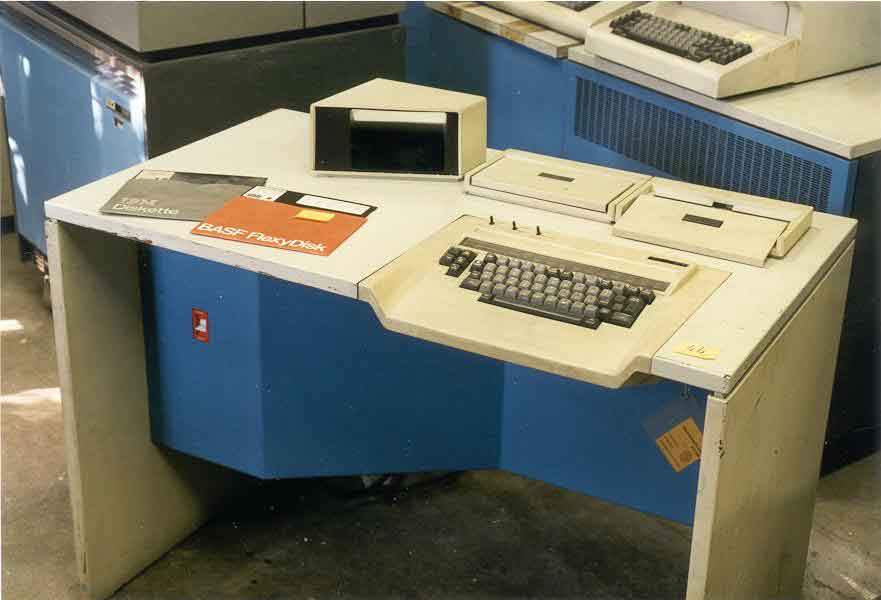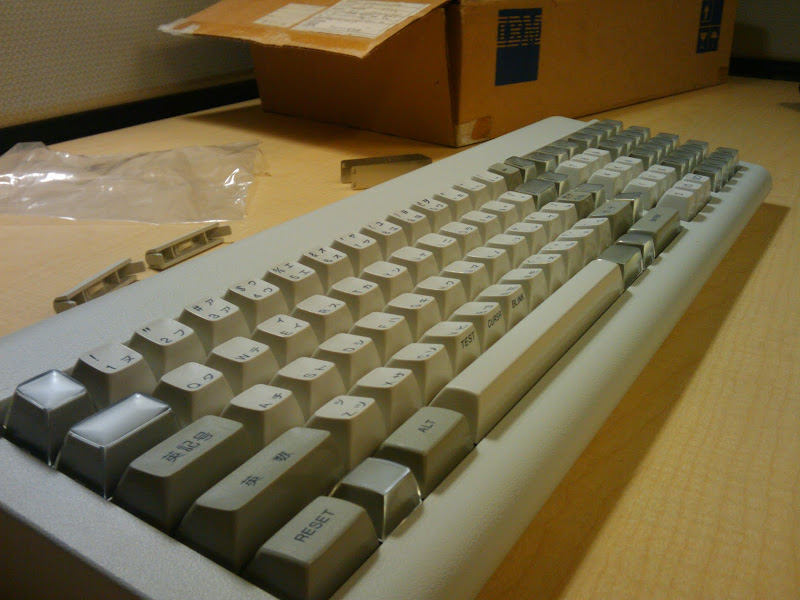Page 1 of 1
(Somewhat) more compact cases for IBM 3278 beam spring?
Posted: 18 Aug 2014, 20:58
by Hypersphere
Posted: 18 Aug 2014, 23:21
by Muirium
Beam springs are huge. There's no getting around it…

IBM developed the Model F as a low profile replacement, and they certainly advertised it as such, compared to the "typewriter style keyboard" beam spring models. So while the layouts may be similar, these cases won't be deep enough to house beam spring mechanisms. Or at least I'd be surprised if they could.
Posted: 19 Aug 2014, 00:01
by andrewjoy
You could always make your own case for it! You have to love IBM there low cost alternative to a beam spring was the model F that was still over-engineered ( that's not a bad thing) and then they try to cut the price again and come up with the model M that is still built like a tank.
I wonder what happened to the models G H I J K L or does the M and F stand for something i wonder , who knows IBM do love there strange names and acronyms then again when you pretty much invented everything you can call it what you like

.
Back on topic
I would just get some sort of wrist rest to support your arms and embrace the size.
Or grow bigger hands.
Posted: 19 Aug 2014, 00:07
by Halvar
Hypersphere wrote: Does anyone here know if any of the cases from alternative keyboards to the 3278 beam spring (or others I have overlooked) would accommodate the internal keyboard assembly of the IBM 3278 beam spring keyboard?
I don't think there will be compatible cases from IBM, for the reasons that Muirium gave, but there is definitely some unneeded height in the outer 3278 case, maybe about 5 or 6 mm. The keyboard itself is in an inner case that cannot be made smaller I think, but you could design an outer case that is less high and maybe less steep, too.
The hard but ideal solution would be to make a case that can replace the inner case in a way that renders the outer case obsolete...

That way you could probably save 8-10 mm of height.
The problem with all this: the keyboard alone, from the lower plate to the top of the key cap is still 50 mm! So you're really not gaining too much. It would probably be better to use a lower table.
Posted: 19 Aug 2014, 00:16
by Muirium
IBM did indeed think of that:
 http://deskthority.net/workshop-f7/beam ... ml#p163927
http://deskthority.net/workshop-f7/beam ... ml#p163927
@Andrew: the letters F and M do in fact stand for something. F is for "fly plate", which is the flipper on the underside of Model F's buckling springs; the crucial component the capacitative sensing detects and makes the keyboard work. That capsense system is actually very similar to the earlier beam spring's (which is how Xwhatsit tackled them both with his controller), although the polarity is reversed! Meanwhile, the M is for "membrane", the Model M's dirty secret. Out went the capsense and in came the same direct electric contact technology still found in cheap keyboards today. That also brought limited rollover and a susceptibility to getting wrecked by spills. Still, they kept most everything else right at least.
Posted: 19 Aug 2014, 00:25
by Daniel Beardsmore
Muirium wrote: IBM did indeed think of that: …
Looks like a target for your knees to aim for.
Muirium wrote: @Andrew: the letters F and M do in fact stand for something.
Citation needed.
Posted: 19 Aug 2014, 00:48
by Hypersphere
Muirium wrote: Beam springs are huge. There's no getting around it…

IBM developed the Model F as a low profile replacement, and they certainly advertised it as such, compared to the "typewriter style keyboard" beam spring models. So while the layouts may be similar, these cases won't be deep enough to house beam spring mechanisms. Or at least I'd be surprised if they could.
Given all the numbers on the beam spring patent figure, they might have included the dimensions! They could be depicting something as tall as a Saturn V rocket or as diminutive as a nanobot. However, some of the posters in this thread gave some quantitative information that will be helpful. Eventually, I will get around to refurbishing, at which time I can get the measurements I need. Looks like I will be either using the stock case or possibly building one myself.
Posted: 19 Aug 2014, 00:55
by Muirium
Daniel Beardsmore wrote:
Muirium wrote: @Andrew: the letters F and M do in fact stand for something.
Citation needed.
I think Dorkvader was the first to explain this to me, back when I was very new to all this, via PM. Anyone with a proper printed IBM source is welcome to pipe up.
Posted: 19 Aug 2014, 01:14
by Halvar
Model M for membrane sounds so convincing I would hardly believe anything else even with a source...
But F for fly plate doesn't make a lot of sense to me since beam spring switches had something that was called "Fly Plate", while in Model F those were replaced by "Pivot Plates". Maybe the latter wwere still also called fly plates, but it was at least nothing new with Model F..
Posted: 19 Aug 2014, 01:25
by Muirium
Searched my PMs (thanks for adding that function Webwit, it's proving very useful!) and, not so surprising, I only remembered half right. Dorkvader wrote this to me in July 2013, and I've continued making the mistake all too often since!
dorkvader wrote:By the way, "flip plates" are part of the switch mechanism for mode F keyboards (or "flip plate keyboards" as is more common in ibm parlance. beam springs are called "fly plates"). The model M equivalent is usually called a hammer. I think you can put a flip plate into a model M switch, but it'll feel different, I imagine.
I've swapped springs between the two since then (feasible, and perhaps necessary once all the F springs go bad someday) but not the plates / hammers themselves. The plastic frames they sit inside, beneath the barrels, are indeed identical as far as I can tell.
Posted: 19 Aug 2014, 02:31
by Hypersphere
F = flip or fly; M = mallet. (Sorry, no documentation!).
Posted: 19 Aug 2014, 11:27
by JBert
Another theory is that "model F" was based on some continuation of model naming scheme for workstations.
See for example
http://www-01.ibm.com/support/knowledge ... rouble.htm to have just an overview in the numbering insanity.
I guess only someone at IBM would have known, though he must have been driven mad.
Posted: 19 Aug 2014, 20:50
by dorkvader
Muirium wrote: Daniel Beardsmore wrote:
Muirium wrote: @Andrew: the letters F and M do in fact stand for something.
Citation needed.
I think Dorkvader was the first to explain this to me, back when I was very new to all this, via PM. Anyone with a proper printed IBM source is welcome to pipe up.
I head that the F stood for 'flip-plate' and the M for 'membrane,' but I think of it as a mnemonic rather than anything official.
Posted: 19 Aug 2014, 21:05
by Muirium
It's a good mnemonic. Almost too good!
I honestly don't understand IBM's naming conventions at all, and any time I have to remember what something is called I go searching for its nickname instead! Thank goodness for Kishsavers and Great Whites.
Posted: 19 Aug 2014, 23:24
by Halvar
What are Great Whites?
Posted: 19 Aug 2014, 23:34
by Nuum
Posted: 20 Aug 2014, 03:19
by dorkvader
Muirium wrote: It's a good mnemonic. Almost too good!
I honestly don't understand IBM's naming conventions at all, and any time I have to remember what something is called I go searching for its nickname instead! Thank goodness for Kishsavers and Great Whites.
I like mnemonics. That's why I'm pushing for "pingmaster" instead of "IBM chinese / japanese tee-mount alps keyboard" or "IBM 6112884" Much easier to remember.
Posted: 20 Aug 2014, 17:10
by Muirium
Ah, especially as the IBM number changes arbitrarily with different language models.
 http://deskthority.net/photos-f62/ibm-5 ... t4564.html
http://deskthority.net/photos-f62/ibm-5 ... t4564.html
Great name. What's different about them compared to the (seemingly) similar switches in the Apple M0110?


